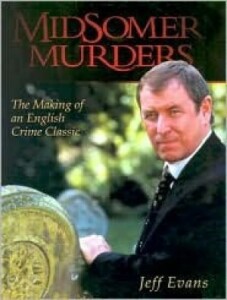As I noted in my review of the first set of Midsomer Murders DVDs, which Acorn Media has released here in the States:
Midsomer Murders series is based on the novels by Caroline Graham, with scripts written by some of Britain’s best television writers. These adaptations have captured the feel of the novels rather well, and Midsomer Murders is firmly established as one of the most popular television series in the United Kingdom. There’s even a new book that covers everything, and I mean everything, you want to know about the series!
 I’m assuming that you are indeed a fan of this ever-so-wonderful series about murder and mayhem in rural England, or you wouldn’t be reading this review, so I won’t bore you with a detailed look at the series itself. My hunch is that you’re interested in whether Midsomer Murders: The Making of an English Crime Classic is worth ordering via Amazon UK. Short answer: oh, yes. You can order via this link and save your time reading this review.
I’m assuming that you are indeed a fan of this ever-so-wonderful series about murder and mayhem in rural England, or you wouldn’t be reading this review, so I won’t bore you with a detailed look at the series itself. My hunch is that you’re interested in whether Midsomer Murders: The Making of an English Crime Classic is worth ordering via Amazon UK. Short answer: oh, yes. You can order via this link and save your time reading this review.
Still here? Oh, well. Brew up a cup of Earl Grey while I gather my notes …
From the cover illustration of DCI Barnaby, with his hand on a very old gravestone, to the detailed episode guide, complete with exacting lists of the casts involved, this guide covers everything the devoted fan needs to know. This is not surprising, as Jeff Evans is a TV historian and author of The Penguin TV Companion, which is the definitive look at English television. He has written for a number of entertainment magazines and various radio and television series. He has also edited many books covering subjects ranging from travel to beer. He was editor of the best-selling annual Good Beer Guide for eight years. Good beer certainly forms part of the appeal of Midsomer Murders, as quaint pubs are often featured, so it’s not hard to make the connection.
We start off this guide with an appropriate quote from the definitive urban English detective, Sherlock Holmes, from Sir Conan Doyle’s “The Copper Beechs”: “It is my belief, Watson, founded upon my experience, that the lowest and vilest alleys in London do not present a more dreadful record of sin than does the smiling and beautiful countryside.” A concise preface follows with some of the gruesome ways that murder most horrid is committed: pitchforks in the abdomen, decapitation by ornamental sword, burning alive. Brrrr! This is followed by a charming foreword by John Nettles, the actor who plays DCI Barnaby, in which he sums up who he thinks Barnaby is. It makes for interesting reading.
What follows in a mere 192 pages (total) is an equivalent to the great English fictional device invented by the late Douglas Adams that was called The Hitchhikers Guide to The Galaxy — everything you need to know about Midsomer Murders. Want to know the music that helps create the background feel? Turn to page thirty-eight for a look at how a BAFTA award-winning composer explains the way that the music is done — including the startling (for me at least) fact that a theremin is used to produce the wailing sound one often hears as something terribly bad is about to happen. (Gary Whitehouse, in his review of Albert Glinsky’s Theremin: Ether Music and Espionage, said of its use in The Beach Boys’ “Good Vibrations,” “It’s the instrument that makes those swooping electronic howls during the chorus, sounding like a computerized operatic soprano with her finger slammed in a car door.”) With some thirty-five to fifty different pieces of music in every EP, Jim has his work cut out for him!
Another favorite chapter for me was the one titled ‘The Real Midsomer,’ which takes a look at the real places where the series was filmed in Buckinghamshire and Oxfordshire counties, and contrasts them with the neatly drawn Midsomer County. (Note to Acorn Media — you really should license some of this material for the DVDs!) Causton, where DCI Barnaby and his family live, is actually the Thames-side town of Wallingford. But no single actual town is where an entire fictional town is filmed. Producer Brian True-May notes, “The script might call for a church to be here, the village hall there, someone’s house there, so we might use three villages to make just one.” This was slightly depressing to discover, as I had been treating the villages as real. Oh, well!
I will not detail everything here, as you too should discover the joys of this ever-so-rare creature: a well-written and useful companion to a television series. There are, of course, detailed looks at each episode and much, much more. Good stuff indeed!
(B.T. Batsford, 2002)
